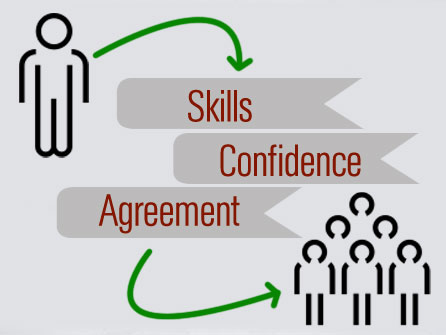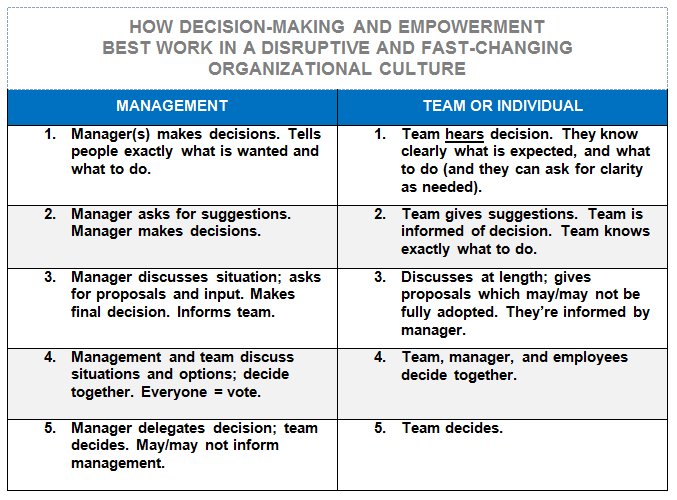Do you work in employee management? How do you motivate employees to work harder? These three simple rules will help increase employee engagement.
1. First, you must be absolutely clear on the values and goals of your company.
If you don’t know these, then your first assignment is cut out for you. Until company heads know implicitly what they seek to accomplish, they cannot expect loyalty from their subordinates. No one follows an indecisive leader into battle, or on the job front. It is essential then that both employer and employee know and appreciate the company philosophy and goals. After your company objectives are securely in place, recruiting supportive employees and educating old ones becomes your next priority. You may find that you will need to let go of people who aren’t aligned with your newfound objectives.
“Bill,” a colleague of mine and president of a small brokerage firm, hired a man who was an extremely talented broker. Problems began to arise, however, when Bill noticed that “Glen” was not a team player. Glen didn’t support the direction Bill was taking the company and, as a result, Glen became apathetic to company matters. The other employees began taking sides, and eventually company morale diminished. Glen’s inability to follow Bill’s lead split the company in two and destroyed what Bill had worked hard to accomplish. The firm went under.
To avoid hiring someone who wouldn’t be my definition of a high-quality employee, I place a lot of weight on first impressions. When I am in the hiring process, I take note of whether a prospective employee is on time to our appointment. I want someone who displays responsible behavior right from the start. I also pay close attention to loose indications of loyalty: involvement in the interview, knowledge of the company for which they are interviewing, manner in which they talk about past employers, and reliability in keeping promises like “I will send you a copy of my resume today” or “I will call to set up a second interview for Tuesday.”
Company heads should diligently look for people who have strong work ethics and share enthusiasm about the company direction. This practice prevents excessive employee turnover and misplacement of people in jobs. It is important to continually clarify and reiterate company values and goals to employees. Executives of The Ford Motor Company utilized this knowledge a few years back to speed the company’s recovery process. Ford developed the motivational acronym MVGP that stands for “Mission, Values, and Guiding Principles.” MVGP spells out what Ford stands for, what it expects from its employees, and the level of quality to which it aspires. A copy of the MVGP plan was mailed to all Ford employees. The letters MVGP are plastered all over the walls of the corporate offices and over the walls of the automotive plants.
2. Apply specific feedback right after a task is accomplished.
Judy Komaki of Perdue University undertook a study touting the importance of feedback. According to Komaki, feedback specifically applied to activities right after they are done gives subordinates a feeling of purpose and as such, has a performance-enhancing effect. In contrast to Komaki’s findings, if communication only takes the form of instructions from the supervisor, subordinates often do the minimum to get by. When a job is well done, positive feedback from management encourages employees to “keep up the good work.” Years ago I worked as a consultant for a company that provided financial planning for middle-income families. Planners weren’t building clientele as quickly as market research indicated was possible. I identified the problem as one of low manager involvement. Managers weren’t giving planners specific feedback on their work and consequently, clear sales strategies and motivation were lacking. I instructed managers to first select particular skills for planners to develop and then monitor the results of the practiced skills. Monitoring resulted in an immediate increase in sales for the organization.
Employee involvement techniques such as participative decision-making, selfmanaging work teams, and suggestion systems raise morale and feelings of responsibility and involvement. Studies show that the larger a person’s stake in a company, the greater his level of loyalty. Communication encourages loyalty.
3. In order to increase employee engagement, all individuals, everyone in the organization, must work to achieve objectivity.
This applies to everyone, from the executive suite to the mail room. Objectivity is the gift of power bestowed upon employees by employers, enabling them to step outside the system for the purpose of accessing what’s wrong. If people are given the tools for attaining objectivity, they will seldom feel a loss of control over themselves and situations. An investment in seminars and literature to this effect will prove highly worthwhile.
Generally, employees in large companies are responsible for a fraction of the whole picture. Objectivity reminds them of the company goal, allowing these workers the insight to move forward. The dreaded disease of apathy often accompanies the feeling of ineffectiveness. If employees feel they can contribute, loyalty will be enhanced.
In summary:
• Employers can inspire loyalty in employees if three important factors are in place as discussed above. Loyalty hinges on the alignment of values between employee and employer. If an employee finds value in the company cause, he or she will naturally support it.
• Objectivity fosters feelings of effectiveness because it allows one to positively influence a situation. If an employee feels like a non-contributor, he or she has no perception of her worth in the company, no feeling of influence or purpose. He or she will atrophy, and the company will eventually lose this employee’s strength.
• Open communication is an extremely important ingredient for instilling loyalty. Constructive feedback keeps an employee posted on his or her relationship to the company works and as a result, he or she is likelier to take pride and responsibility in his or her actions and contributions.




